
- Home
- Travel Packages
- Top Destination
-
Travel Attraction
By Category
Top Attraction

- Travel Agents
- Car Rentals
- Hotels

About The Hadimba Temple The Hadimba Temple, also known as the Hidimba Devi Temple, is a unique temple located in Manali, Himachal Pradesh. It is dedicated to Hidimba Devi, a character from the Indian epic Mahabharata. The temple is surrounded by beautiful cedar forests and is a popular tourist destination in Manali. Architecture Of Hadimba Temple The Hadimba Temple is built in a pagoda style with intricately carved wooden doors, walls, and a cone-shaped roof. The temple is adorned with figures and symbols of animals and deities from Hindu mythology. The architecture of the temple is a fine example of traditional Himachali craftsmanship and attracts visitors from all over the world. History The Hadimba Temple was built in 1553 by Raja Bahadur Singh of Kullu. It is believed that the temple was constructed in honor of Hidimba Devi, the wife of Bhima, one of the Pandava brothers. Legend has it that Hidimba Devi performed penance at this spot and was blessed by the gods with divine powers. Best Time To Visit The best time to visit the Hadimba Temple is during the summer months of March to June when the weather is pleasant and the surrounding landscapes are lush green. The temple is also beautifully decorated during the Dussehra festival, which falls in October. It is advisable to avoid visiting during the winter months as the region experiences heavy snowfall. How To Reach The Hadimba Temple is located in the heart of Manali and is easily accessible by road. Manali is well-connected by road to major cities like Delhi, Chandigarh, and Shimla. The nearest airport is Kullu-Manali Airport, which is around 50 kilometers away from the temple. Visitors can also take a bus or hire a taxi to reach the temple from Manali town. Significance Of The Hadimba Temple The Hadimba Temple holds great significance for the local people of Manali as well as for tourists. It is believed that worshipping Hidimba Devi at this temple helps in seeking her blessings for protection and prosperity. The temple is also a popular pilgrimage site for devotees of the goddess. The serene surroundings and peaceful ambiance of the temple make it a perfect place for meditation and spiritual contemplation.
Explore More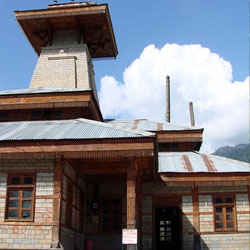
About The Manu Temple The Manu Temple in Manali is dedicated to the sage Manu, who is believed to be the creator of the world and the writer of the ancient Indian scriptures, the Manusmriti. It is believed that Manali gets its name from Manu, who is said to have meditated in this area. The temple is a popular pilgrimage site and a must-visit for those seeking spiritual solace in the lap of the Himalayas. Architecture Of Manu Temple The Manu Temple is built in the traditional Himachali style of architecture, with wooden carvings adorning its facade. The temple is located on the banks of the Beas River, surrounded by lush green forests and snow-capped mountains. The beauty of the temple lies in its simplicity and tranquility, making it a serene place for meditation and prayer. History The Manu Temple is steeped in history and mythology. According to legend, Manu saved the Vedas and the seven sages from the great flood by building a boat and sailing to safety. It is believed that Manu settled in Manali after the flood and established a new civilization. The temple stands as a testimony to his legacy and the ancient roots of Indian culture. Best Time To Visit The best time to visit the Manu Temple is during the summer months of April to June, when the weather is pleasant and the flowers are in full bloom. The monsoon season from July to September brings heavy rainfall, making it difficult to navigate the hilly terrain. Winter, from October to February, brings snowfall and freezing temperatures, making it challenging to reach the temple. How To Reach The Manu Temple is located in the old town of Manali, about 3 km from the main market. Visitors can reach the temple by taking a short walk along the winding pathways or hire a taxi or auto-rickshaw from the town center. The nearest airport is Kullu-Manali Airport, about 50 km away, and the nearest railway station is Joginder Nagar Railway Station, about 165 km away. Significance Of The Manu Temple The Manu Temple holds great significance for the locals and pilgrims who visit to seek the blessings of the sage Manu. It is believed that a dip in the holy waters of the Beas River near the temple can cleanse one of their sins and bring peace and prosperity. The temple also offers panoramic views of the surrounding mountains and valleys, making it a peaceful retreat for those seeking spiritual fulfillment.
Explore More
About The Raghunath Temple The Raghunath Temple is a significant religious site in the picturesque Kullu town in Himachal Pradesh, India. Dedicated to Lord Raghunath, an incarnation of Lord Vishnu, this temple holds immense religious and cultural importance for the locals as well as tourists visiting the region. The temple is known for its stunning architecture, serene surroundings, and spiritual ambiance that attracts devotees from far and wide. Architecture Of Raghunath Temple The Raghunath Temple is a fine example of traditional Himachali architecture. The temple complex comprises a cluster of beautifully crafted wooden structures with intricate carvings and detailed designs. The main temple is adorned with a pagoda-style roof, intricately carved wooden doors, and a shikhara that stands tall against the majestic Himalayas. The temple is surrounded by lush greenery, adding to its charm and tranquility. History The Raghunath Temple was built in the 17th century by Raja Jagat Singh of Kullu. The temple was constructed as an act of penance to atone for the sin of killing a brahmin. It is believed that the idol of Lord Raghunath enshrined in the temple was brought here from Ayodhya. The temple complex also houses a collection of ancient scriptures and manuscripts that provide insights into the rich history and cultural heritage of the region. Best Time To Visit The best time to visit the Raghunath Temple is during March to June and September to November when the weather is pleasant and conducive for sightseeing. The temple is also a popular pilgrimage site during the festivals of Dussehra and Diwali when devotees flock to seek blessings and witness the grand celebrations that take place in and around the temple complex. How To Reach The Raghunath Temple is located in the heart of Kullu town, making it easily accessible by road. The nearest airport is Bhuntar Airport, which is approximately 10 kilometers away from Kullu. The temple is well-connected by road to major cities like Delhi, Chandigarh, and Manali. Visitors can also opt for local transport or hire a taxi to reach the temple from their respective locations. Significance Of The Raghunath Temple The Raghunath Temple holds immense significance for the people of Kullu and is considered a symbol of faith and devotion. The temple is believed to bring peace, prosperity, and good fortune to those who visit and offer prayers here. It is also a popular destination for spiritual seekers and tourists seeking solace and inner peace amidst the tranquil surroundings of the temple complex. The annual festivals and rituals held at the temple attract a large number of devotees who come to seek blessings and participate in the religious and cultural festivities.
Explore More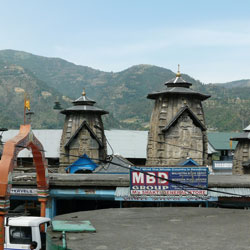
About The Laxmi Narayan Temple The Laxmi Narayan Temple, also known as the Lakshmi Narayan Temple, is a famous Hindu temple located in Chamba, Himachal Pradesh, India. Dedicated to Lord Vishnu and Goddess Lakshmi, this temple is one of the oldest and most significant temples in the region. The temple complex consists of six main temples, with the main shrine dedicated to Lord Vishnu. Architecture Of Laxmi Narayan Temple The Laxmi Narayan Temple is built in the traditional Himachali architectural style, with a mix of both Hindu and Mughal influences. The temple is made of stone and features intricate carvings and sculptures depicting various Hindu deities and scenes from Hindu mythology. The temple complex is surrounded by beautiful gardens, adding to its overall charm and serenity. History The Laxmi Narayan Temple was built in the 10th century by Raja Sahil Varman, the founder of the Chamba dynasty. Over the centuries, the temple has undergone several renovations and additions, with the latest restoration works carried out in the 19th century. The temple stands as a testament to the rich cultural and religious heritage of the region and continues to attract devotees and tourists from all over the world. Best Time To Visit The best time to visit the Laxmi Narayan Temple is during the months of March to June, when the weather is pleasant and the gardens surrounding the temple are in full bloom. The temple also hosts various festivals and religious ceremonies throughout the year, with the Navratri festival being one of the most popular events celebrated at the temple. How To Reach The Laxmi Narayan Temple is located in Chamba town, which is well-connected by road to major cities like Delhi, Chandigarh, and Shimla. The nearest airport is in Gaggal, which is approximately 120 kilometers away from Chamba. The nearest railway station is in Pathankot, which is about 100 kilometers from Chamba. From the town of Chamba, the temple is easily accessible by local transport like taxis and buses. Significance Of The Laxmi Narayan Temple The Laxmi Narayan Temple holds immense religious and cultural significance for the people of Chamba and the surrounding regions. Devotees visit the temple to seek the blessings of Lord Vishnu and Goddess Lakshmi for prosperity and happiness. The temple is also a popular tourist attraction, known for its stunning architecture and serene surroundings. The Laxmi Narayan Temple is not just a place of worship but also a symbol of the rich history and heritage of Chamba.
Explore More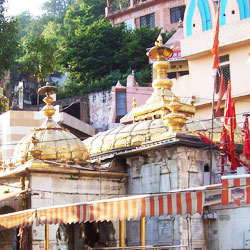
About The Jwalamukhi Temple The Jwalamukhi Temple is a famous Hindu temple located in the Kangra district of Himachal Pradesh, India. It is dedicated to Goddess Jwalamukhi, also known as the "Flaming Goddess". The temple is one of the 51 Shakti Peethas in India and holds great religious significance for devotees. Architecture Of Jwalamukhi Temple The Jwalamukhi Temple is built in the traditional North Indian architectural style with a striking pagoda-shaped roof. The main sanctum of the temple houses a sacred flame that is said to be burning continuously for centuries. The temple complex also features various smaller shrines dedicated to different Hindu deities, along with beautiful carvings and sculptures that adorn the walls. History The history of the Jwalamukhi Temple dates back to ancient times and is shrouded in legend. According to mythology, it is believed that the tongue of Goddess Sati fell at this spot after Lord Vishnu cut her body into pieces to stop Lord Shiva's Tandava dance of destruction. This is where the divine flame of Goddess Jwalamukhi emerged, and the temple was built to worship her in this form. Best Time To Visit The best time to visit the Jwalamukhi Temple is during the months of March to June and September to November when the weather is pleasant and conducive for travel. It is advisable to avoid visiting during the monsoon season as the region experiences heavy rainfall which can disrupt travel plans. How To Reach The Jwalamukhi Temple is easily accessible by road from major cities in Himachal Pradesh such as Dharamshala and Kangra. The nearest airport is the Kangra Airport which is located about 50 kilometers away from the temple. Visitors can also take a train to Pathankot Railway Station which is around 120 kilometers from the temple and then hire a taxi or bus to reach the temple. Significance Of The Jwalamukhi Temple The Jwalamukhi Temple holds immense significance for Hindu devotees who come from far and wide to seek the blessings of the Goddess. The eternal flame burning in the temple is believed to be a manifestation of the Goddess's power and is said to fulfill the wishes of those who offer prayers with a pure heart. The temple is also considered a powerful spiritual center where devotees can experience a sense of peace and inner tranquility.
Explore More
About The Chinmaya Tapovan Temple The Chinmaya Tapovan Temple is a spiritual retreat located in Dharamshala, Himachal Pradesh. It is a serene and tranquil place that offers spiritual seekers a peaceful and serene environment to practice meditation and self-reflection. Founded by Swami Chinmayananda, the temple is dedicated to Lord Rama and is a popular destination for devotees and tourists alike. Architecture Of Chinmaya Tapovan Temple The architecture of the Chinmaya Tapovan Temple is inspired by traditional Indian temple architecture, with intricate carvings and beautiful sculptures adorning the walls. The temple is surrounded by lush greenery and offers stunning views of the Himalayan mountains, making it a truly picturesque setting for spiritual practice. History The Chinmaya Tapovan Temple was established in 1978 by Swami Chinmayananda, a renowned spiritual leader and teacher. Swami Chinmayananda believed in the power of self-realization and spiritual growth through meditation and study of ancient scriptures. The temple was set up as a place for seekers to come and immerse themselves in spiritual practice and contemplation. Best Time To Visit The best time to visit the Chinmaya Tapovan Temple is during the months of March to June and September to November, when the weather is pleasant and conducive to spiritual practice. The temple also holds special events and retreats during these months, making it an ideal time to visit for those seeking a deeper spiritual experience. How To Reach The Chinmaya Tapovan Temple is located in Sidhbari, a small village near Dharamshala. The nearest airport is in Gaggal, which is about 15 kilometers away from the temple. Visitors can also reach the temple by road, as it is well-connected to major cities like Delhi and Chandigarh. Buses and taxis are available from Dharamshala to Sidhbari, making it easy to reach the temple. Significance Of The Chinmaya Tapovan Temple The Chinmaya Tapovan Temple holds great significance for those seeking spiritual growth and self-realization. The temple offers a peaceful and serene environment for meditation and contemplation, allowing visitors to connect with their inner self and find peace and solace. The teachings of Swami Chinmayananda are deeply ingrained in the temple's philosophy, making it a unique and sacred place for spiritual seekers.
Explore More
About The Saho Temple The Saho Temple is dedicated to Lord Shiva and is believed to have been built in the 8th century. It is one of the oldest temples in the region and is known for its intricate carvings and stunning architecture. The temple is surrounded by lush greenery and offers a serene and peaceful atmosphere for devotees to pray and meditate. Architecture Of Saho Temple The Saho Temple is a fine example of traditional Himachali architecture. The temple is built using wood and stone, with intricate carvings and designs adorning its walls and pillars. The temple has a pyramidal roof with ornate wooden carvings that represent various Hindu deities and mythological figures. The inner sanctum of the temple houses a Shiva Lingam, which is worshipped by devotees with great devotion. The temple also has a beautiful courtyard with a sacred water tank where pilgrims can take a dip before entering the main shrine. History The history of the Saho Temple dates back to the 8th century when it was believed to have been constructed by the local rulers of Chamba. The temple has undergone several renovations and restorations over the centuries, but its original charm and grandeur have been well preserved. The temple is considered a symbol of the rich cultural heritage of Himachal Pradesh and is a testament to the architectural skills of the craftsmen of that era. Best Time To Visit The best time to visit the Saho Temple is during the months of March to June when the weather is pleasant and the surrounding landscapes are lush and green. The monsoon season from July to September should be avoided as heavy rainfall can make it difficult to explore the temple premises. The winter months from November to February are also a good time to visit if you enjoy the cold weather and want to witness the temple adorned with snow. How To Reach The Saho Temple is located in the town of Chamba, which is well connected by road to major cities like Delhi and Chandigarh. The nearest airport is in Dharamshala, which is about 120 kilometers away, and the nearest railway station is in Pathankot, which is about 100 kilometers away. From Chamba town, you can hire a taxi or take a local bus to reach the temple, which is situated on a hill overlooking the town. Significance Of The Saho Temple The Saho Temple holds immense religious significance for the people of Chamba and is considered a sacred place of worship for devotees of Lord Shiva. The temple is also an important cultural landmark and a symbol of the rich heritage of Himachal Pradesh. Pilgrims and tourists flock to the temple to seek blessings, offer prayers, and marvel at its architectural beauty. The serene and tranquil atmosphere of the temple makes it an ideal place for meditation and spiritual contemplation.
Explore More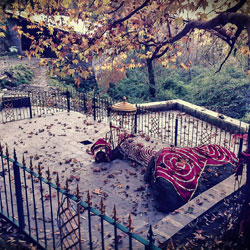
About The Sui Mata Temple The Sui Mata Temple is a popular religious site located in Chamba, Himachal Pradesh, dedicated to the legendary Queen Sui, who sacrificed her life for the safety and well-being of her people. The temple is nestled amidst the picturesque surroundings of the Chamba Valley and is a significant pilgrimage destination for devotees and history enthusiasts alike. Architecture Of Sui Mata Temple The Sui Mata Temple boasts exquisite architectural details that reflect the rich cultural heritage of the region. The temple is built in the traditional Himachali style, with wooden carvings, intricate designs, and vibrant frescoes adorning the walls. The pagoda-style structure of the temple is a sight to behold, and visitors can marvel at the craftsmanship and attention to detail that went into its construction. History The history of the Sui Mata Temple dates back to ancient times when Queen Sui, the daughter of King Sauvan Singh, ruled over Chamba. Legend has it that during a severe drought, Queen Sui selflessly offered herself as a sacrifice to the rain gods to bring relief to her people. Her act of sacrifice is celebrated in the form of the Sui Mata Temple, which stands as a testament to her bravery and devotion. The temple is a symbol of love and sacrifice, and visitors can learn about the fascinating history of Queen Sui through the various sculptures and inscriptions inside the temple. Best Time To Visit The best time to visit the Sui Mata Temple is during the months of March to June and September to November when the weather is pleasant, and the surrounding landscapes are lush and green. Visitors can enjoy exploring the temple complex, taking in the breathtaking views of the Chamba Valley, and participating in religious ceremonies and festivals that are held throughout the year. How To Reach The Sui Mata Temple is located in Chamba, Himachal Pradesh, and is easily accessible by road. Visitors can reach Chamba by taking a bus or hiring a taxi from nearby cities like Pathankot or Dharamshala. The nearest airport is in Dharamshala, while the closest railway station is in Pathankot. From Chamba town, the temple is a short drive away, and visitors can enjoy a scenic journey through the picturesque landscapes of the region. Significance Of The Sui Mata Temple The Sui Mata Temple holds great significance for the people of Chamba and is revered as a sacred site dedicated to Queen Sui. Devotees flock to the temple to seek blessings for prosperity, well-being, and protection. The temple is also a cultural landmark that showcases the unique architectural style and historical legacy of the region. Visitors can experience a sense of peace and spirituality as they explore the temple complex and learn about the inspiring tale of Queen Sui and her selfless sacrifice.
Explore More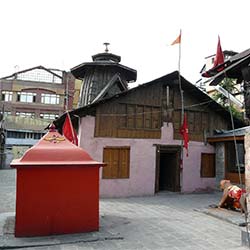
About The Champavati Temple The Champavati Temple is an ancient Hindu temple located in the town of Chamba in Himachal Pradesh, India. It is dedicated to Goddess Champavati, who is believed to be the patron deity of the Chamba royal family. The temple is a fine example of the architectural style prevalent in the region and is a popular pilgrimage site for locals and tourists. Architecture Of Champavati Temple The Champavati Temple features a unique blend of architectural styles, including both Hindu and Mughal influences. The temple is built in the traditional North Indian style, with a square base and a pyramidal roof. The walls of the temple are adorned with intricate carvings and sculptures, depicting various gods and goddesses. The main sanctum of the temple houses a black stone idol of Goddess Champavati, which is worshipped by devotees. History The Champavati Temple was built by King Sahil Varman in the 9th century AD in honor of his daughter Champavati. According to legend, Champavati was a devoted follower of Goddess Durga and performed various miracles to protect the people of Chamba. The temple has since been renovated and expanded by subsequent rulers of the region, but it still retains its original charm and grandeur. Best Time To Visit The best time to visit the Champavati Temple is during the summer months, from March to June when the weather is pleasant and conducive to sightseeing. The temple also hosts various festivals and fairs throughout the year, including the Champavati Temple Fair, which is held in honor of Goddess Champavati and attracts a large number of devotees. How To Reach The Champavati Temple is located in the heart of Chamba town and is easily accessible by road. The nearest airport is in Kangra, approximately 170 km away, while the nearest railway station is in Pathankot, around 120 km away. From there, visitors can hire a taxi or take a bus to reach Chamba and explore the temple and its surroundings. Significance Of The Champavati Temple The Champavati Temple holds great religious and cultural significance for the people of Chamba. It is believed to be a place of divine power and blessings, and devotees come from far and wide to seek the blessings of Goddess Champavati. The temple also serves as a cultural hub, hosting various music and dance performances, as well as religious ceremonies and rituals.
Explore More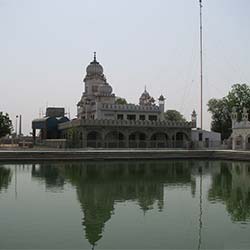
About The Hariraya Temple In Chamba The Hariraya Temple is a significant historical site located in the picturesque town of Chamba in Himachal Pradesh, India. This temple is dedicated to Lord Vishnu and is considered one of the oldest temples in the region. The temple is known for its stunning architecture, intricate carvings, and rich history, making it a must-visit for history buffs and architecture enthusiasts. Architecture Of Hariraya Temple The Hariraya Temple is a prime example of the traditional architectural style of the region. The temple is built using stone and wood, with intricate carvings adorning the walls and pillars. The main sanctum sanctorum of the temple houses a beautifully carved idol of Lord Vishnu, along with other deities. The temple has a shikhara-style roof, typical of the North Indian architectural style, with a curved top and intricate carvings. The outer walls of the temple are decorated with sculptures depicting various mythological scenes, adding to the overall beauty of the structure. History The Hariraya Temple is believed to have been built in the 10th century by Raja Sahil Varman, the founder of the Chamba dynasty. The temple was constructed as a tribute to Lord Vishnu, the preserver of the universe, and has since been a place of worship for devotees from far and wide. Over the centuries, the temple has undergone several renovations and restorations to preserve its architectural beauty and historical significance. The Hariraya Temple stands as a testimony to the rich cultural heritage of Chamba and continues to attract visitors seeking spiritual solace and architectural marvel. Best Time To Visit The best time to visit the Hariraya Temple is during the summer months, from March to June, when the weather is pleasant and the surroundings are lush and green. The temple sees a large number of visitors during the annual festival of Sui Mata, which takes place in March-April and is a vibrant celebration of the local culture and traditions. How To Reach The Hariraya Temple is located in the heart of Chamba town, making it easily accessible by various modes of transport. Visitors can reach Chamba by road from nearby cities like Pathankot and Dharamshala, or by taking a direct bus from major towns in Himachal Pradesh. For those traveling by air, the nearest airport is in Dharamshala, which is well-connected to major cities in India. From Dharamshala, visitors can hire a taxi or take a bus to reach Chamba and explore the Hariraya Temple and other attractions in the town. Significance Of The Hariraya Temple The Hariraya Temple holds great significance for the locals and devotees who visit the temple to seek the blessings of Lord Vishnu. The temple is believed to be a place of divine energy and spiritual healing, making it a popular pilgrimage site for those seeking solace and inner peace. The temple is also a cultural hub, where various festivals and rituals are celebrated with great enthusiasm and fervor. The annual festival of Sui Mata is a major highlight at the Hariraya Temple, drawing crowds from far and wide to witness the vibrant celebrations and pay homage to the local deity.
Explore More
About The Shri Hari Rai Temple The Shri Hari Rai Temple, located in Chamba, Himachal Pradesh, is a significant historical and religious site that attracts tourists and pilgrims from far and wide. This temple is dedicated to Lord Vishnu, specifically to his avatar Hari Rai. The temple is known for its exquisite architecture, stunning surroundings, and rich cultural heritage. Architecture Of Shri Hari Rai Temple The Shri Hari Rai Temple showcases the traditional architectural style of the region, characterized by intricate wood carvings, sloping roofs, and ornate designs. The temple is built on a raised platform, with a shikara (spire) that rises above the main sanctum sanctorum. The interiors of the temple are adorned with beautiful sculptures and paintings that depict scenes from Hindu mythology. History The Shri Hari Rai Temple was built in the 11th century by Raja Sahil Varman, the founder of the Chamba dynasty. The temple was constructed to honor Lord Vishnu and has since been a place of worship for devotees seeking blessings and spiritual solace. Over the centuries, the temple has undergone several renovations and restorations to preserve its historical and cultural significance. Best Time To Visit The best time to visit the Shri Hari Rai Temple is during the months of March to June when the weather is pleasant and the surrounding landscape is lush and green. Another ideal time to visit is during the festival of Navratri, which is celebrated with great enthusiasm and grandeur at the temple. How To Reach The Shri Hari Rai Temple is located in the heart of Chamba town, making it easily accessible for visitors. The nearest airport is in Kangra, approximately 172 kilometers away, while the nearest railway station is in Pathankot, around 120 kilometers from Chamba. Visitors can also reach Chamba by road through well-connected state highways. Significance Of The Shri Hari Rai Temple The Shri Hari Rai Temple holds immense religious and cultural significance for the people of Chamba and devotees of Lord Vishnu. The temple is believed to bestow blessings of prosperity, peace, and happiness upon its visitors. It is also a symbol of the rich heritage and architectural prowess of the region, attracting history buffs and art enthusiasts alike.
Explore More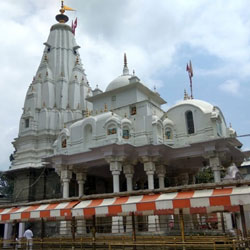
About The Vajreshwari Temple The Vajreshwari Temple, located in Chamba, Himachal Pradesh, is a sacred Hindu temple dedicated to the goddess Vajreshwari. The temple is nestled amidst the picturesque surroundings of the Himalayan foothills, making it a serene and spiritual destination for pilgrims and tourists alike. Architecture Of Vajreshwari Temple The Vajreshwari Temple showcases the traditional architecture of the region, with intricate carvings and sculptures adorning its walls and pillars. The temple's main sanctum is built in the nagara style, characterized by its pyramid-shaped shikhara (spire) and ornate decorations. The beautiful wooden doors and windows of the temple add to its charm, making it a sight to behold for visitors. History The history of the Vajreshwari Temple dates back several centuries, with records suggesting that it was built during the reign of Raja Sahil Varman in the 9th century. Over the years, the temple has undergone several renovations and additions, but has retained its spiritual significance and architectural beauty. Legend has it that the goddess Vajreshwari manifested herself at the site of the temple to bless her devotees, making it a popular pilgrimage destination. Best Time To Visit The best time to visit the Vajreshwari Temple is during the months of March to June, when the weather is pleasant and the surrounding hills are lush green. The temple also sees a large number of visitors during Navratri and other festivals dedicated to the goddess Vajreshwari, when the temple is adorned with lights and decorations, creating a festive atmosphere. How To Reach The Vajreshwari Temple is easily accessible by road from Chamba town, which is well connected to major cities in Himachal Pradesh and neighboring states. Visitors can also reach the temple by taking a taxi or a private vehicle from Chamba, enjoying the scenic drive through the winding roads of the Himalayan region. The nearest airport is in Dharamshala, approximately 120 kilometers away, while the nearest railway station is in Pathankot, around 120 kilometers from Chamba. Significance Of The Vajreshwari Temple The Vajreshwari Temple holds great significance for followers of the goddess Vajreshwari, who believe that worshipping her at the temple can bring blessings of prosperity, good health, and protection from evil forces. Devotees offer prayers and perform rituals at the temple to seek the goddess's divine intervention in their lives, making it a place of faith and devotion for many. The temple also serves as a cultural heritage site, showcasing the rich architectural and religious traditions of the region.
Explore MoreHimachal 9 Days - 8 Nights Tour Package
9 Days/ 8 Night
Dalhousie - Khajjiar - Kufri - Kullu - Manali - Shimla - Dharamshala
5 Night 6 Days Shimla - Manali Tour Ex - Delhi
6 Days/ 5 Night
Kufri - Kullu - Manali - Manikaran - Shimla
Blissful Kullu - Manali Tour Package
4 Days/ 3 Night
Manali
Jibhi - Tirthan Valley Trip Package From Delhi
4 Days/ 3 Night
Jibhi

About The Katasan Devi Temple In Chamba The Katasan Devi Temple is a popular Hindu temple located in Chamba, Himachal Pradesh. Situated at an altitude of 6,500 feet above sea level, this ancient temple is dedicated to Goddess Kali, who is worshipped as the main deity here. The temple is famous for its serene surroundings and breathtaking views of the snow-capped Himalayan mountains. Architecture Of Katasan Devi Temple The Katasan Devi Temple is built in the traditional hill architecture style that is typical of the temples in Himachal Pradesh. The temple is made of wood and stone, with intricate carvings and designs adorning its walls and ceilings. The main sanctum sanctorum houses the idol of Goddess Kali, which is worshipped by the devotees who visit the temple. The temple complex also includes smaller shrines dedicated to other deities, as well as a sacred pond where devotees can take a dip to cleanse their sins. The surrounding area is filled with lush greenery and offers a peaceful atmosphere for meditation and prayers. History The history of the Katasan Devi Temple dates back several centuries, with some sources claiming that the temple was built over 800 years ago. According to local legends, the temple was established by a group of saints who were drawn to the area by the divine energy that emanated from the place. Over the years, the temple has undergone several renovations and restorations to maintain its structural integrity and religious significance. The temple continues to attract pilgrims and tourists from far and wide who come to seek the blessings of Goddess Kali. Best Time To Visit The best time to visit the Katasan Devi Temple is during the summer months from March to June when the weather is pleasant and the surrounding hills are covered in a blanket of greenery. The monsoon season from July to September should be avoided as heavy rainfall can make the journey to the temple difficult and unsafe. Another good time to visit the temple is during the winter months from November to February when the area is covered in snow and the temple takes on a magical appearance. However, it is important to be prepared for cold temperatures and snowfall during this time. How To Reach The Katasan Devi Temple is located approximately 25 kilometers from Chamba town and can be reached by road. The nearest airport is in Dharamshala, which is about 140 kilometers away, while the nearest railway station is in Pathankot, which is around 120 kilometers from the temple. From Chamba town, visitors can hire a taxi or take a local bus to reach the temple. The journey to the temple is through winding roads that offer stunning views of the surrounding valleys and mountains. Significance Of The Katasan Devi Temple The Katasan Devi Temple holds great religious significance for the people of Himachal Pradesh and is considered a sacred pilgrimage site. Devotees believe that worshipping Goddess Kali at the temple can help in seeking protection from evil forces and negative energies. The temple also attracts tourists who are drawn to its architectural beauty and spiritual ambiance. Many visitors come to the temple seeking peace and solace in the midst of the serene surroundings and pristine natural beauty that surrounds the temple.
Explore More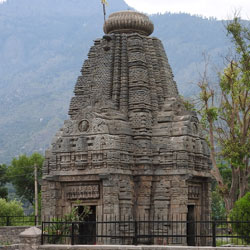
About The Basheshwar Mahadev Temple The Basheshwar Mahadev Temple is a famous Hindu temple located in the scenic Kullu Valley of Himachal Pradesh, India. It is dedicated to Lord Shiva, also known as Mahadev, and is one of the oldest temples in the region. The temple is known for its stunning architecture, intricate stone carvings, and serene atmosphere that attracts devotees and tourists alike. Architecture of Basheshwar Mahadev Temple The architecture of the Basheshwar Mahadev Temple is a fine example of traditional Himachali style. The temple is built in the Pahari style of architecture, characterized by its wooden structure, intricate carvings, and sloping slate roof. The temple complex consists of a sanctum sanctorum, a mandapa (hall), and a shikhara (spire) that is adorned with intricate stone carvings depicting various Hindu deities and mythological stories. The walls of the temple are decorated with beautiful sculptures of gods, goddesses, and celestial beings. The entrance of the temple is marked by a beautifully carved wooden door, leading to the sanctum where the main deity, Lord Shiva, is enshrined in the form of a sacred lingam. The tranquil surroundings of the temple and the majestic views of the surrounding mountains add to the spiritual ambiance of the place. History The history of the Basheshwar Mahadev Temple dates back to the 9th century when it was built by the rulers of the Kullu Kingdom. The temple is believed to have been constructed by Raja Keshav Prakash of the Jalandhari Devi Temple in Bajaura, Himachal Pradesh. The temple has undergone several renovations and restorations over the centuries, but its original architectural beauty and spiritual significance have been well preserved. The Basheshwar Mahadev Temple is dedicated to Lord Shiva, who is worshipped as the supreme deity of creation, destruction, and transformation in Hindu mythology. Devotees visit the temple to seek blessings, offer prayers, and perform rituals to honor the divine power of Lord Shiva. Best Time To Visit The best time to visit the Basheshwar Mahadev Temple is during the months of March to June and September to November when the weather is pleasant and the temple premises are adorned with lush greenery. The temple witnesses a large number of devotees during the festivals of Maha Shivaratri and Shravan month when special prayers and rituals are conducted. How To Reach The Basheshwar Mahadev Temple is located in Bajaura village, approximately 15 kilometers from Kullu town in Himachal Pradesh. The nearest airport is Bhuntar Airport, which is about 30 kilometers away from the temple. The temple can be easily reached by road from Kullu or Bhuntar via private taxis, buses, or rental cars. Significance Of The Basheshwar Mahadev Temple The Basheshwar Mahadev Temple holds great significance for the local community and devotees who believe in the divine power of Lord Shiva. The temple is considered a sacred place where one can seek solace, inner peace, and spiritual enlightenment. Devotees offer prayers, perform rituals, and make offerings to Lord Shiva to seek his blessings for prosperity, health, and well-being. The temple also serves as a cultural and historical landmark in the region, attracting tourists and history enthusiasts who are interested in exploring the rich heritage and architectural beauty of the temple. The serene ambiance, stunning views, and spiritual aura of the Basheshwar Mahadev Temple make it a must-visit destination for people seeking a divine experience in the lap of nature.
Explore More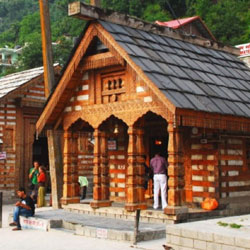
About The Maa Sharvari Temple The Maa Sharvari Temple, located in the picturesque town of Kullu in Himachal Pradesh, is a revered shrine dedicated to Goddess Durga. The temple holds immense religious significance for the locals and attracts a large number of devotees and tourists every year. The temple is situated amidst the lush greenery and serene surroundings of Kullu Valley, offering a tranquil and spiritual experience to visitors. Architecture Of Maa Sharvari Temple The Maa Sharvari Temple is built in traditional Himachali architectural style, with intricate wooden carvings and vibrant colors adorning the structure. The temple complex consists of a main sanctum sanctorum where the idol of Goddess Durga is enshrined, along with other smaller shrines dedicated to various deities. The temple also features beautifully landscaped gardens, providing a peaceful and serene ambiance for devotees to offer their prayers. History The history of the Maa Sharvari Temple dates back several centuries, with the exact origins shrouded in myth and legend. According to local folklore, the temple is believed to have been established by Raja Jagat Singh of Kullu in honor of Goddess Durga, who is considered the presiding deity of the Kullu Valley. Over the years, the temple has undergone various renovations and additions, but has retained its spiritual significance and aura of divine presence. Best Time To Visit The Maa Sharvari Temple can be visited throughout the year, but the best time to experience the temple's cultural and religious festivities is during the festival of Navratri. Navratri is a nine-day long festival dedicated to Goddess Durga, during which the temple is adorned with colorful decorations and hosts special prayers and rituals. The festival usually falls in the months of September-October and draws a large number of devotees from far and wide. How To Reach The Maa Sharvari Temple is located in the heart of Kullu town, making it easily accessible by road from major cities in Himachal Pradesh such as Manali and Shimla. The nearest airport to Kullu is Bhuntar Airport, which is well-connected to major cities in India. Visitors can also opt for buses or taxis to reach the temple from nearby towns and cities. The scenic drive to the temple offers breathtaking views of the Himalayan mountains and the Beas River. Significance Of The Maa Sharvari Temple The Maa Sharvari Temple holds immense spiritual significance for the people of Kullu and is considered a sacred place of worship for devotees seeking blessings from Goddess Durga. The temple is believed to fulfill the wishes of those who pray with a pure heart and devotion. It is also a popular pilgrimage destination for tourists who seek spiritual solace amidst the tranquil beauty of the Kullu Valley. The serene ambiance of the temple, coupled with its rich cultural heritage, makes it a must-visit destination for those exploring the spiritual and religious attractions of Himachal Pradesh.
Explore More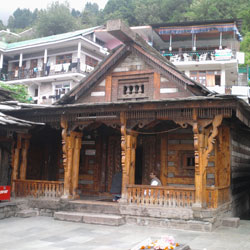
Vashist Hot Water Springs and Temple
About The Vashist Hot Water Springs And Temple The Vashist Hot Water Springs and Temple are a popular tourist attraction located in the quaint village of Vashist, just 3 kilometers away from Manali in Himachal Pradesh, India. The natural hot springs are believed to have medicinal properties and are surrounded by stunning views of the Himalayas, making it a must-visit destination for travelers seeking relaxation and spiritual rejuvenation. Architecture Of Vashist Hot Water Springs and Temple The Vashist Hot Water Springs and Temple showcase traditional Himachali architecture with intricate wooden carvings and a pagoda-style roof. The temple is dedicated to the sage Vashist, who is revered for his healing powers and spiritual wisdom. The hot water springs flow through stone spouts into separate bathing areas for men and women, creating a serene and peaceful atmosphere for visitors. History The history of the Vashist Hot Water Springs and Temple dates back to ancient times when it was believed that the sage Vashist used his powers to create the natural hot springs for the benefit of humanity. Over the years, the temple and springs have become a pilgrimage site for devotees seeking blessings and healing from the sacred waters. Best Time To Visit The best time to visit the Vashist Hot Water Springs and Temple is during the summer months from March to June when the weather is pleasant and ideal for exploring the surrounding area. The spring and autumn months of September to November also offer a beautiful backdrop of colorful foliage and clear skies. It is recommended to avoid visiting during the monsoon season from July to August due to heavy rainfall and slippery roads. How To Reach The Vashist Hot Water Springs and Temple are easily accessible from Manali by road. Visitors can take a taxi or hire a private vehicle to reach the village of Vashist, which is located just a short drive away. The nearest airport is Kullu-Manali Airport, approximately 50 kilometers away, and the nearest railway station is Joginder Nagar Railway Station, around 166 kilometers away. From there, travelers can take a local bus or taxi to reach the hot springs and temple. Significance Of The Vashist Hot Water Springs and Temple The Vashist Hot Water Springs and Temple hold great significance for both locals and tourists alike. The natural hot springs are believed to have healing properties that can cure various ailments and provide relief from pain and stress. Many devotees come to the temple to offer prayers and seek blessings from the sage Vashist for good health and prosperity. The tranquil atmosphere of the temple complex and the surrounding natural beauty make it a peaceful retreat for those seeking spiritual solace and inner peace.
Explore More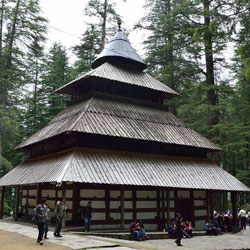
About The Vashisht Temple The Vashisht Temple is located in the quaint village of Vashisht, just a couple of kilometers away from the bustling town of Manali in Himachal Pradesh, India. This ancient temple is dedicated to the sage Vashisht, who is believed to have meditated here. Architecture Of Vashisht Temple The Vashisht Temple is a beautiful example of traditional Himachali architecture. The temple is built using stone and wood, giving it a rustic yet charming look. The intricate carvings on the wooden doors and walls showcase the skilled craftsmanship of the local artisans. The temple is surrounded by lush greenery and offers stunning views of the Himalayas. History The Vashisht Temple has a long and fascinating history. According to legend, sage Vashisht chose this serene location to meditate and seek solace from the world. It is believed that the temple dates back to the 16th century and has been a place of worship for centuries. The temple is also famous for its hot water springs, which are said to have healing properties. Best Time To Visit The best time to visit the Vashisht Temple is during the summer months, from March to June when the weather is pleasant and the surroundings are lush and green. The temple can also be visited during the winter months, from October to February, when the region is covered in snow, creating a magical winter wonderland. How To Reach The Vashisht Temple is easily accessible from Manali. Visitors can either take a short trek from Manali to the temple or hire a taxi to reach the village of Vashisht. The temple is located around 3 kilometers from the main market in Manali and can be reached in about 15-20 minutes by road. Significance Of The Vashisht Temple The Vashisht Temple holds great significance for the locals as well as tourists. The temple is a popular pilgrimage site and is visited by devotees seeking blessings and solace. The hot water springs near the temple are also a major attraction, drawing visitors who believe in the healing properties of the water. The temple's serene surroundings and stunning views make it a must-visit destination for anyone traveling to Manali. Visiting the Vashisht Temple is not just a religious experience, but also a cultural and historical one. The centuries-old temple stands as a testament to the rich heritage and traditions of Himachal Pradesh. Whether you are a devotee seeking blessings or a traveler looking to explore the beauty of the region, the Vashisht Temple is a place that should not be missed.
Explore More
About The Jagatsukh Temple The Jagatsukh Temple is a historic temple located in the village of Jagatsukh near Manali in the Indian state of Himachal Pradesh. It is dedicated to Lord Shiva and is one of the oldest temples in the Kullu Valley. The temple is known for its unique architecture and serene surroundings, making it a popular destination for tourists and devotees alike. Architecture Of Jagatsukh Temple The Jagatsukh Temple showcases traditional Himachali architecture with wooden carvings and intricate designs. The temple has a pagoda-style roof and is adorned with beautiful sculptures of Hindu deities. The intricate carvings on the walls and pillars of the temple reflect the rich cultural heritage of the region. The temple complex also houses a smaller shrine dedicated to Goddess Sandhya, the consort of Lord Shiva. History The Jagatsukh Temple was built in the 8th century by Raja Jagat Singh of Kullu. The temple holds great historical significance as it is believed to have been the royal temple of the Kullu kings. The temple served as a place of worship and meditation for the royal family and their subjects. Over the centuries, the temple has undergone several renovations and restorations, but its original charm and spiritual essence have been preserved. Best Time To Visit The best time to visit the Jagatsukh Temple is during the summer months from March to June when the weather is pleasant and ideal for sightseeing. The temple is also visited by devotees during the festival of Mahashivratri, which falls in the month of February or March. The winter months from October to February are also a good time to visit the temple, especially for those who enjoy the snow-covered landscapes of Himachal Pradesh. How To Reach The Jagatsukh Temple is located in the village of Jagatsukh, which is about 6 kilometers from the town of Manali. The temple can be easily reached by road from Manali through private taxis, buses, or rented vehicles. The nearest airport to Manali is in Bhuntar, which is about 50 kilometers away. The nearest railway station is in Joginder Nagar, which is about 145 kilometers from Manali. Significance Of The Jagatsukh Temple The Jagatsukh Temple holds immense religious significance for the locals as well as tourists. The temple is believed to be a sacred place where devotees can seek blessings from Lord Shiva and Goddess Sandhya for peace and prosperity. The serene surroundings of the temple make it an ideal place for meditation and spiritual retreat. The annual festival of Mahashivratri is celebrated with great fervor at the temple, attracting thousands of devotees from far and wide.
Explore More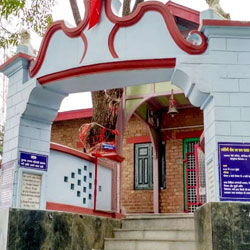
About The Kamna Devi Temple The Kamna Devi Temple is a revered Hindu temple located in Shimla, Himachal Pradesh. Situated at an altitude of 2155 meters, the temple is dedicated to Goddess Kali, also known as Kamna Devi. It is a popular pilgrimage site and a must-visit for both locals and tourists seeking blessings and spiritual solace. Architecture Of Kamna Devi Temple The Kamna Devi Temple showcases traditional Hindu architecture with intricate carvings and designs. The temple is built using wood and stone, giving it a rustic yet elegant look. The structure is adorned with colorful flags and decorations, adding to its charm and spiritual ambiance. The temple offers panoramic views of the surrounding mountains and valleys, making it a scenic spot for devotees and visitors alike. History The Kamna Devi Temple has a rich history dating back several centuries. It is believed that the temple was built by the erstwhile rulers of the region to honor Goddess Kali and seek her blessings for prosperity and protection. Over the years, the temple has undergone renovations and expansions, but its spiritual significance remains intact. Devotees flock to the temple during Navratri and other auspicious occasions to pay their respects and offer prayers to the goddess. Best Time To Visit The best time to visit the Kamna Devi Temple is during the months of March to June and September to November when the weather is pleasant and conducive for exploring the temple premises. The summer months offer clear skies and cool temperatures, making it ideal for trekking and sightseeing. Avoid visiting the temple during the monsoon season as the region receives heavy rainfall, which can make the journey challenging. How To Reach The Kamna Devi Temple is easily accessible from Shimla city center, located approximately 6 kilometers away. Visitors can reach the temple by taking a taxi or hiring a private vehicle. The nearest railway station is in Shimla, which is well-connected to major cities in India. Those traveling by air can reach Shimla via the nearest airport in Chandigarh, followed by a scenic drive to the temple. Significance Of The Kamna Devi Temple The Kamna Devi Temple holds immense significance for devotees who believe in the power and blessings of Goddess Kali. It is considered a sacred site where prayers are answered, and wishes are fulfilled. The temple attracts a large number of pilgrims who come to seek divine intervention for their personal and professional endeavors. Many visitors also come to witness the stunning views from the temple premises and soak in the spiritual energy that permeates the surroundings.
Explore More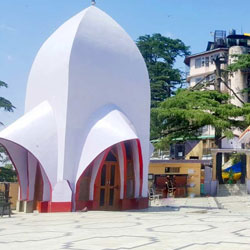
About The Kali Bari Temple in Shimla The Kali Bari Temple in Shimla is a famous Hindu temple dedicated to Goddess Kali. It is located near Mall Road in Shimla and is one of the most visited temples in the region. The temple is known for its beautiful architecture, serene surroundings, and spiritual significance. Architecture of Kali Bari Temple The Kali Bari Temple is built in a traditional North Indian architectural style, with intricate carvings and beautiful paintings adorning its walls. The temple complex consists of the main shrine dedicated to Goddess Kali, along with smaller shrines dedicated to other Hindu deities. The temple also has a large courtyard where devotees can sit and meditate in peace. The main shrine of the temple houses a black stone idol of Goddess Kali, adorned with garlands of flowers and other offerings. The idol is believed to be very powerful and devotees come from far and wide to seek the blessings of the Goddess. History The Kali Bari Temple was built in the early 19th century by a Bengali Brahmin priest who settled in Shimla. The priest was a devotee of Goddess Kali and wanted to build a temple dedicated to her in the region. Over the years, the temple has undergone several renovations and expansions, but its original charm and spiritual significance have remained intact. Best Time To Visit The best time to visit the Kali Bari Temple is during the months of October to March when the weather in Shimla is pleasant and the temple is less crowded. The temple is also beautifully decorated during the Durga Puja festival, which is celebrated with great fervor in the region. How To Reach The Kali Bari Temple is easily accessible from the Mall Road in Shimla, which is well-connected by road and is a popular tourist destination. Visitors can either walk to the temple from the Mall Road, or take a taxi or auto rickshaw to reach there. The temple is located a short distance from the Shimla Railway Station and the ISBT, making it convenient for travelers to visit. Significance Of The Kali Bari Temple The Kali Bari Temple holds great spiritual significance for the people of Shimla and is visited by hundreds of devotees every day. The temple is believed to fulfill the wishes of those who worship with a pure heart and devotion. It is also considered to be a place of healing and protection, where devotees seek the blessings of Goddess Kali for good health and prosperity.
Explore More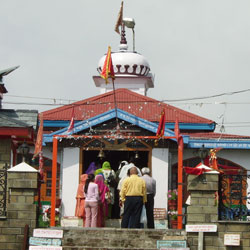
About The Tara Devi Temple The Tara Devi Temple is a popular Hindu temple located in Shimla, Himachal Pradesh. It is situated on top of a hill, offering panoramic views of the surrounding mountains and the city. The temple is dedicated to Goddess Tara Devi, a form of Goddess Kali, who is believed to fulfill the wishes of her devotees. Architecture Of Tara Devi Temple The Tara Devi Temple is built in a traditional Himachali style of architecture, with wooden carvings and intricate designs adorning the structure. The temple complex consists of the main shrine dedicated to Goddess Tara Devi, along with smaller shrines dedicated to Lord Shiva and Lord Hanuman. The temple is surrounded by lush green forests, adding to its serene and peaceful ambiance. History The Tara Devi Temple has a long and rich history dating back to several centuries. It is believed that the temple was built around 250 years ago by a king from the Sen dynasty. The king was a devout follower of Goddess Tara Devi and wanted to build a temple in her honor. Over the years, the temple has undergone renovations and expansions, becoming a significant pilgrimage site for devotees. Best Time To Visit The best time to visit the Tara Devi Temple is during the months of March to June and September to November when the weather is pleasant and ideal for sightseeing. The temple witnesses a large number of devotees and tourists during the Navratri festival, which falls in the months of March-April and October-November. It is advisable to avoid visiting during the monsoon season as the hill roads can be slippery and dangerous. How To Reach The Tara Devi Temple is located at a distance of approximately 11 kilometers from Shimla, making it easily accessible by road. One can either hire a taxi or take a local bus from Shimla to reach the temple. The nearest railway station is in Shimla, which is well-connected to major cities like Delhi and Chandigarh. The nearest airport is in Jubbarhatti, around 23 kilometers away from the temple. Significance Of The Tara Devi Temple The Tara Devi Temple holds great religious significance among the devotees, who believe that Goddess Tara Devi grants their wishes and protects them from evil forces. Many people visit the temple to seek blessings for good health, prosperity, and overall well-being. The temple also attracts tourists who come to admire the stunning views of the surrounding mountains and valleys from the hilltop location.
Explore More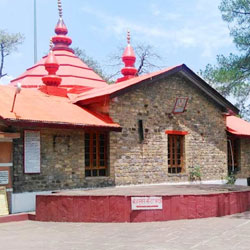
About The Sankat Mochan Temple in Shimla The Sankat Mochan Temple is a renowned Hindu temple located in the picturesque hill station of Shimla in Himachal Pradesh, India. Dedicated to Lord Hanuman, the temple is a sacred place of worship and is visited by devotees from all around the country. The temple is situated amidst lush green surroundings, offering a peaceful and serene atmosphere for visitors to seek blessings and find solace. Architecture of Sankat Mochan Temple The Sankat Mochan Temple is built in the traditional North Indian architectural style, with intricate carvings and beautiful designs adorning its structure. The temple has a simple yet elegant facade, with a sloping roof and wooden doors. The interiors of the temple are adorned with murals and paintings depicting scenes from Hindu mythology, adding to the spiritual ambiance of the place. The main sanctum of the temple houses the idol of Lord Hanuman, the monkey god known for his strength and devotion. The idol is adorned with garlands of flowers and offerings from devotees, creating a divine and peaceful atmosphere within the temple premises. The temple complex also includes smaller shrines dedicated to other Hindu deities, providing a comprehensive spiritual experience for visitors. History The Sankat Mochan Temple has a rich history dating back several centuries. It is said that the temple was established by Baba Neeb Karori Maharaj, a revered saint and devotee of Lord Hanuman. The temple has since become a popular pilgrimage site for devotees seeking blessings and divine intervention in times of trouble and distress. Over the years, the temple has undergone several renovations and expansions to accommodate the growing number of visitors and devotees. Today, the Sankat Mochan Temple stands as a symbol of faith and devotion, attracting pilgrims from far and wide to seek solace and blessings from the revered deity. Best Time To Visit The best time to visit the Sankat Mochan Temple is during the months of March to June and September to November when the weather in Shimla is pleasant and conducive for sightseeing. The temple is especially crowded during the festival of Hanuman Jayanti, celebrated with great fervor and devotion by devotees. How To Reach The Sankat Mochan Temple is located in the town of Shimla, which is well-connected by road, rail, and air. The nearest airport is located in Chandigarh, approximately 113 kilometers away, while the nearest railway station is in Kalka, about 96 kilometers from Shimla. From Shimla, visitors can take a taxi or a local bus to reach the temple, which is situated at a short distance from the town center. Significance Of The Sankat Mochan Temple The Sankat Mochan Temple holds great significance for devotees who believe in the power and blessings of Lord Hanuman. It is believed that visiting the temple and offering prayers to the deity can help alleviate one's troubles, fears, and obstacles in life. Many devotees visit the temple to seek protection, courage, and strength from the revered deity, who is known as the remover of all obstacles, or "Sankat Mochan".
Explore More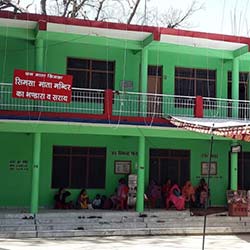
About The Simsa Mata Temple The Simsa Mata Temple is a revered Hindu temple located in Mandi, Himachal Pradesh. It is dedicated to Goddess Simsa Mata, who is believed to be a form of Goddess Durga. The temple is situated on a hilltop, offering breathtaking views of the surrounding valley and mountains. Devotees visit the temple to seek blessings from the Goddess and to witness the stunning natural beauty that surrounds it. Architecture Of Simsa Mata Temple The architecture of the Simsa Mata Temple is a fine example of traditional Himachali style. The temple is built using wood and stone, with intricate carvings and designs adorning its exterior. The main sanctum sanctorum houses the idol of Goddess Simsa Mata, adorned with ornate decorations and offerings from devotees. The temple complex also includes a yajnashala (fire pit) where rituals are performed, as well as other smaller shrines dedicated to various deities. History The history of the Simsa Mata Temple dates back several centuries. It is believed that the temple was established by a local king to honor Goddess Simsa Mata, who is considered to be the guardian deity of the region. Over the years, the temple has undergone several renovations and expansions but has retained its original charm and spiritual significance. Devotees from far and wide visit the temple to pay their respects to the Goddess and seek her blessings. Best Time To Visit The best time to visit the Simsa Mata Temple is during the months of March to June and September to November when the weather is pleasant and favorable for sightseeing. The temple is especially crowded during the Navratri festival, a nine-day celebration dedicated to Goddess Durga, when devotees flock to the temple to offer prayers and seek blessings. It is advisable to avoid visiting the temple during the monsoon season, as the region experiences heavy rainfall that can make the journey difficult. How To Reach The Simsa Mata Temple is located in the Mandi district of Himachal Pradesh and is easily accessible by road. The nearest major town is Mandi, which is well-connected to other cities by bus and taxi services. Visitors can also hire a private vehicle to reach the temple, as it is situated atop a hill and requires a short trek to reach the entrance. The closest airport is located in Bhuntar, approximately 65 kilometers away, while the nearest railway station is in Jogindernagar, around 55 kilometers from the temple. Significance Of The Simsa Mata Temple The Simsa Mata Temple holds great significance for the local community as well as devotees from across the country. The Goddess is believed to be a protector of the region and is worshipped for her grace and blessings. Devotees visit the temple to seek solutions to their problems, offer prayers for their well-being, and express their gratitude for the Goddess's blessings. The serene surroundings and spiritual atmosphere of the temple make it a popular destination for those seeking solace and inner peace.
Explore More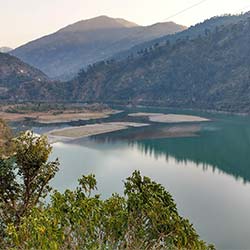
About The Pandoh Dam Temple In Mandi The Pandoh Dam Temple, located near the town of Mandi in Himachal Pradesh, is a popular religious and tourist destination in the region. Nestled amidst the picturesque surroundings of the Pandoh Dam, this temple is dedicated to the Hindu deity Lord Shiva. The serene atmosphere and stunning views of the dam make it a must-visit for both devotees and nature lovers. Architecture Of Pandoh Dam Temple The Pandoh Dam Temple showcases beautiful traditional Himachali architecture, with intricate carvings and designs that reflect the rich cultural heritage of the region. The temple is built on the banks of the Beas River, offering devotees a peaceful and serene place to worship and seek blessings. The serene surroundings and tranquil ambiance add to the spiritual experience of visitors. History The Pandoh Dam Temple has a long and rich history dating back centuries. It is believed to have been built by the Pandavas during their exile, making it a significant historical and religious site for Hindus. The temple has witnessed the rise and fall of various dynasties and empires over the years, adding to its cultural and historical importance. Best Time To Visit The best time to visit the Pandoh Dam Temple is during the months of March to June and September to November when the weather is pleasant and ideal for exploring the outdoors. The lush green surroundings and blooming flowers during these months enhance the beauty of the temple and make it a perfect destination for nature enthusiasts. How To Reach The Pandoh Dam Temple is easily accessible by road from Mandi, which is well-connected to major cities like Delhi, Chandigarh, and Shimla. Tourists can hire a taxi or take a bus to reach the temple from Mandi. The nearest railway station is Joginder Nagar, located about 50 kilometers away, and the nearest airport is in Bhuntar, approximately 60 kilometers from the temple. Significance Of The Pandoh Dam Temple The Pandoh Dam Temple holds great religious significance for devotees of Lord Shiva. It is believed that worshipping at the temple can bring peace, prosperity, and happiness to one's life. The tranquil surroundings of the temple, combined with the spiritual vibes, make it a popular destination for those seeking solace and divine blessings.
Explore MoreWeekend Trip To Manali Package
5 Days/ 4 Night
Kullu - Manali
Spiti Self Drive Expedition - Free Nako Excursion Tour
9 Days/ 8 Night
Chandigarh City - Narkanda - Lahaul & Spiti - Chitkul - Kalpa - Kaza
Manali Volvo Tour Package
6 Days/ 5 Night
Kullu - Manali - Naggar
5 Nights 6 Days Shimla Manali trip
6 Days/ 5 Night
Shimla - Manali
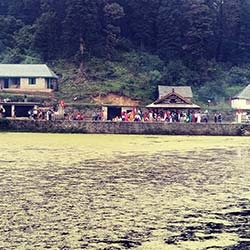
About The Kamru Nag Temple in Mandi The Kamru Nag Temple is a popular ancient temple located in the Mandi district of Himachal Pradesh, India. Dedicated to the serpent deity Kamru Nag, the temple is a significant religious site for the locals as well as tourists who visit the region. Surrounded by the majestic Himalayan mountains, the temple offers a serene and spiritual atmosphere for devotees. Architecture Of Kamru Nag Temple The architecture of Kamru Nag Temple is a fine example of traditional Himachali style. The temple is built using wood and stone, with intricate carvings and designs that reflect the rich cultural heritage of the region. The temple is adorned with colorful flags, bells, and sculptures depicting various mythological stories. History The Kamru Nag Temple has a long and interesting history that dates back to several centuries. It is believed that the temple was established by the local rulers of Mandi to honor the deity Kamru Nag, who is considered to be the protector of the region. Over the years, the temple has undergone renovations and expansions, but its original charm and sanctity have been preserved. Best Time To Visit The best time to visit the Kamru Nag Temple is during the months of April to June and September to November when the weather is pleasant and conducive for sightseeing. During these months, the temple sees a large number of devotees and tourists who come to seek blessings and admire the beauty of the surroundings. How To Reach The Kamru Nag Temple is located in the Mandi district of Himachal Pradesh, which is well connected by road and rail. The nearest airport is Bhuntar Airport, which is about 60 kilometers away from Mandi. From Bhuntar, one can hire a taxi or take a bus to reach the temple. Mandi is also well connected by road to major cities like Chandigarh, Shimla, and Delhi. Significance Of The Kamru Nag Temple The Kamru Nag Temple holds great significance for the local people as well as devotees who come from far and wide to offer prayers and seek blessings. It is believed that worshipping Kamru Nag brings prosperity, good health, and protection from evil forces. The temple also plays a crucial role in preserving the cultural and religious heritage of the region.
Explore More
About The Bhootnath Temple The Bhootnath Temple is a famous Hindu temple located in Mandi, Himachal Pradesh. It is dedicated to Lord Shiva, who is worshipped here in the form of Bhootnath, the ruler of ghosts and spirits. The temple holds great religious significance for the locals and devotees who visit it to seek blessings and fulfill their wishes. Architecture Of Bhootnath Temple The Bhootnath Temple is an architectural marvel that showcases the traditional Himachali style of architecture. The temple is built using wood and stone, with intricate carvings and designs that reflect the rich cultural heritage of the region. The main sanctum sanctorum of the temple houses a Shiva Lingam, and the walls are adorned with beautiful paintings depicting scenes from Hindu mythology. History The history of the Bhootnath Temple dates back to ancient times, with references to the temple found in various historical texts and scriptures. According to legend, the temple was established by Raja Ajber Sen in the 16th century. Over the years, the temple has undergone several renovations and additions, but it has retained its original charm and spiritual aura. Best Time To Visit The best time to visit the Bhootnath Temple is during the months of February to June when the weather is pleasant and conducive for sightseeing and exploring the temple premises. The temple also celebrates various festivals and fairs during this time, attracting a large number of devotees and tourists. How To Reach The Bhootnath Temple is easily accessible by road from Mandi town. Visitors can hire a taxi or take a local bus to reach the temple, which is located in the heart of the town. The nearest railway station is in Joginder Nagar, which is well-connected to major cities like Delhi and Chandigarh. The nearest airport is in Bhuntar, which is approximately 60 kilometers away from Mandi. Significance Of The Bhootnath Temple The Bhootnath Temple holds great religious significance for the locals and devotees who believe that worshipping Lord Shiva at this sacred place can bring peace, prosperity, and fulfillment of their desires. The temple is also believed to be a powerful source of positive energy and spiritual healing. Many pilgrims visit the temple to seek blessings and offer prayers for the well-being of their families and loved ones.
Explore More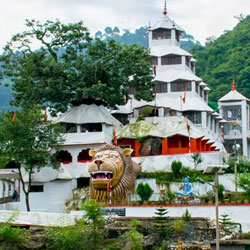
About The Bhimakali Temple The Bhimakali Temple, located in Mandi, Himachal Pradesh, is a popular Hindu temple dedicated to Goddess Bhimakali. It is one of the most important temples in the region and holds great religious significance for the locals as well as visitors. The temple is known for its unique architecture, stunning views, and rich history. Architecture Of Bhimakali Temple The architecture of the Bhimakali Temple is a beautiful blend of Hindu and Tibetan styles. The temple complex is built in wood and stone, with intricate carvings and colorful paintings adorning the walls and pillars. The main shrine of the temple features a pagoda-style roof and a towering shikhar (spire) that is a sight to behold. The temple's surroundings are equally captivating, with lush greenery and snow-capped mountains providing a picturesque backdrop. History The Bhimakali Temple has a rich history that dates back several centuries. It is believed to have been constructed in the 17th century by Raja Shyam Sen of Mandi. The temple was originally dedicated to Goddess Bhimakali, a fierce form of Goddess Durga. Over the years, the temple has undergone several renovations and expansions, with the current structure being the result of various architectural influences. Best Time To Visit The best time to visit the Bhimakali Temple is during the months of March to June and September to November. These months offer pleasant weather and clear skies, making it ideal for exploring the temple and its surroundings. The temple also sees a large number of visitors during the Navratri festival, which is celebrated with great fervor and enthusiasm. How To Reach The Bhimakali Temple is located in Mandi, Himachal Pradesh, and is easily accessible by road. The nearest airport is in Kullu, which is about 100 kilometers away from Mandi. The nearest railway station is in Joginder Nagar, which is well-connected to major cities in the region. The temple is just a short drive away from Mandi town, and there are plenty of taxis and buses available for transportation. Significance Of The Bhimakali Temple The Bhimakali Temple holds great religious significance for the people of Mandi and the surrounding areas. It is believed to be a place of great spiritual power, where devotees come to seek blessings from Goddess Bhimakali. The temple also plays an important role in the cultural life of the region, hosting various festivals and ceremonies throughout the year. The serene surroundings of the temple make it a peaceful retreat for those seeking solace and tranquility.
Explore More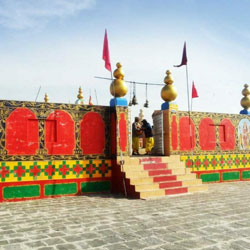
About The Shikari Devi Temple The Shikari Devi Temple is a popular Hindu temple located in the Mandi district of Himachal Pradesh, India. Situated at an altitude of 2850 meters above sea level, the temple is dedicated to Goddess Shikari Devi, who is believed to be the presiding deity of the surrounding hills. The temple is surrounded by lush green forests, offering a serene and tranquil atmosphere for devotees and tourists alike. Architecture Of Shikari Devi Temple The Shikari Devi Temple is built in traditional Himachali architectural style, with wooden carvings and intricate designs adorning the structure. The temple is perched on a hilltop, offering panoramic views of the surrounding valleys and mountains. The main sanctum of the temple houses the idol of Goddess Shikari Devi, which is adorned with ornaments and colorful fabrics. The temple complex also includes smaller shrines dedicated to other deities, as well as a spacious courtyard for devotees to gather and offer prayers. History The history of the Shikari Devi Temple dates back several centuries, with local folklore and legends surrounding its origin. According to popular belief, the temple was built by the Pandavas during their exile, as a tribute to Goddess Shikari Devi for protecting them during their time in the wilderness. Over the years, the temple has become a revered pilgrimage site for devotees seeking blessings and divine intervention from the goddess. Best Time To Visit The best time to visit the Shikari Devi Temple is during the summer months of April to June when the weather is pleasant and conducive for trekking to the temple. The surrounding landscape is lush and green during this time, making it a perfect backdrop for a spiritual retreat. However, the temple can also be visited during the winter months of November to February, when the region experiences snowfall and offers a picturesque setting for visitors. How To Reach The Shikari Devi Temple is located in the Mandi district of Himachal Pradesh, approximately 15 kilometers from Janjehli village. The nearest town with good connectivity is Mandi, which is about 60 kilometers away from the temple. Visitors can reach Mandi by road from major cities like Shimla and Chandigarh, and then hire a taxi or take a local bus to Janjehli village. From Janjehli, a trek of about 8 kilometers through dense forests and steep terrain leads to the temple. Significance Of The Shikari Devi Temple The Shikari Devi Temple holds great significance among the local communities and devotees who believe in the divine powers of Goddess Shikari Devi. It is said that the goddess grants wishes and fulfills the prayers of her devotees, especially those seeking protection and success in their endeavors. Pilgrims from far and wide visit the temple to seek blessings for their families, health, and prosperity. The temple also serves as a cultural and spiritual hub, hosting annual festivals and rituals that attract a large number of devotees and tourists.
Explore More
About The Panchvaktra Temple The Panchvaktra Temple in Mandi, Himachal Pradesh, is a significant religious site dedicated to Lord Shiva. The temple derives its name from the five-faced (Panchvaktra) form of Lord Shiva, symbolizing his five elements - earth, water, fire, sky, and air. It is believed that worshipping at this temple brings peace, prosperity, and fulfillment of wishes. Architecture Of Panchvaktra Temple The Panchvaktra Temple showcases exquisite architectural beauty with intricate carvings and sculptures. The temple is built in traditional Himachali style, featuring wooden beams and stone walls. The main sanctum sanctorum houses the five-faced idol of Lord Shiva, adorned with various ornaments and offerings. The temple complex also includes smaller shrines dedicated to other deities. History The history of the Panchvaktra Temple dates back centuries, with its origins closely tied to ancient legends and folklore. According to local beliefs, the temple was established by a revered saint or sage who had a divine vision of Lord Shiva in his five-faced form. Over the years, the temple has undergone renovations and reconstructions, yet it continues to remain a sacred place of worship for devotees. Best Time To Visit The best time to visit the Panchvaktra Temple is during the months of March to June and September to November when the weather is pleasant and suitable for exploring the temple premises. The temple also sees a significant influx of pilgrims and tourists during the annual Maha Shivaratri festival, celebrated with grandeur and devotion. How To Reach The Panchvaktra Temple is located in Mandi, Himachal Pradesh, making it easily accessible by road. The nearest airport is Bhuntar Airport, approximately 60 kilometers away, while the closest railway station is in Joginder Nagar, around 55 kilometers from Mandi. Visitors can hire taxis or take buses from nearby cities like Shimla or Chandigarh to reach Mandi and then proceed to the temple by local transport. Significance Of The Panchvaktra Temple The Panchvaktra Temple holds immense significance for devotees of Lord Shiva, who consider it a sacred place for seeking blessings and divine intervention. The five-faced form of Lord Shiva symbolizes his omnipresence and omnipotence, representing the essential elements of creation and existence. The temple draws pilgrims and spiritual seekers from far and wide, seeking solace and spiritual enlightenment in the divine presence of Lord Shiva.
Explore More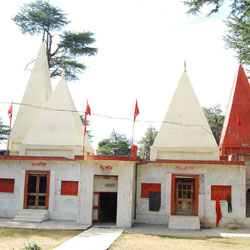
About The Sidh Baba Ka Mandir Temple The Sidh Baba Ka Mandir Temple is a popular religious site located in Chail, Himachal Pradesh. It is dedicated to Sidh Baba, a revered saint known for his miraculous powers. The temple is nestled amidst the lush greenery of the Himalayas, providing a serene and peaceful atmosphere for visitors. Architecture Of Sidh Baba Ka Mandir Temple The architecture of the Sidh Baba Ka Mandir Temple is simple yet elegant. The temple is built in a traditional Himachali style, with wooden walls and a sloping roof. The sanctum sanctorum houses the idol of Sidh Baba, adorned with flowers and incense. The surroundings of the temple are beautifully landscaped, with gardens and seating areas for devotees to relax and meditate. History The history of the Sidh Baba Ka Mandir Temple dates back several centuries. It is believed that Sidh Baba, the revered saint, meditated in the caves near the temple and performed miracles to help the people in the region. Over time, the temple was built to honor his memory and attract pilgrims and devotees from near and far. Best Time To Visit The best time to visit the Sidh Baba Ka Mandir Temple is during the months of March to June when the weather is pleasant and the surroundings are lush and green. The temple is also beautifully decorated during festivals like Navratri and Diwali, attracting a large number of devotees. How To Reach The Sidh Baba Ka Mandir Temple is easily accessible by road. It is located at a distance of about 45 kilometers from Shimla, the capital of Himachal Pradesh. Visitors can hire a taxi or take a bus from Shimla to reach the temple. The nearest railway station is Kalka, which is well-connected to major cities in India. Significance Of The Sidh Baba Ka Mandir Temple The Sidh Baba Ka Mandir Temple holds great significance for the local community and devotees. It is believed that worshipping at the temple can fulfill one's wishes and bring good luck and prosperity. Many people visit the temple to seek blessings from Sidh Baba for health, wealth, and success in their endeavors.
Explore More